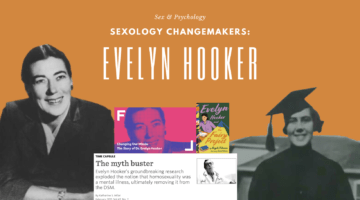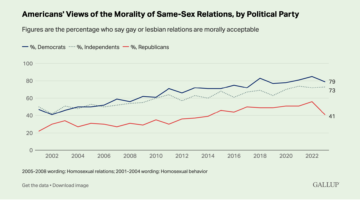Can Men Who Identify as Gay Still be Aroused by Women?
October 5, 2016 by Justin Lehmiller
Many people think about sexual orientation in terms of just three distinct categories: straight, bisexual, and gay. Those who subscribe to this view usually don’t allow for anything in between—they expect that everyone will fit neatly into one of these three boxes.
By contrast, others have argued that sexual orientation is far more complex and is best viewed along a continuum. The idea of a sexual orientation continuum is not new and, in fact, can be traced back to Alfred Kinsey. His classic Kinsey Scale allowed for seven degrees of heterosexuality and homosexuality:
0 – Exclusively heterosexual
1 – Predominately heterosexual, only incidentally homosexual
2 – Predominately heterosexual, but more than incidentally homosexual
3 – Equally heterosexual and homosexual
4 – Predominately homosexual, but more than incidentally heterosexual
5 – Predominately homosexual, only incidentally heterosexual
6 – Exclusively homosexual
The validity of the Kinsey Scale has been questioned by some, though, who have wondered exactly what distinguishes one spot from another on the scale. For example, consider men who classify themselves as Kinsey 5s—what accounts for their selection of 5 rather than 6?
One possibility, of course, is that these men are indeed more sexually attracted to women than men who are exclusively gay. Another, however, is that these men just aren’t willing to admit being completely gay and feel that perhaps it’s more socially acceptable to report bisexual feelings to some degree.
A new study published in the Archives of Sexual Behavior sought to test which of these competing explanations is correct. This paper is part of a forthcoming issue dedicated to “the puzzle of sexual orientation” (for coverage of other articles from this issue on the blog, see here, here, here, and here).
In this study, 58 participants (all of whom currently identified as gay, were mostly White, and were aged 26 on average) completed an online survey about their sexual attitudes and histories. Thirty-six of these men also went on to complete a lab study in which their genital arousal patterns were recorded while they watched different kinds of pornography, including man-on-man and woman-on-woman.
In total, 20 of these men classified themselves as Kinsey 5s (mostly gay), while the remaining 38 classified themselves as Kinsey 6s (exclusively gay). When asked how arousing or disgusting they found the prospect of having sex with a woman to be, the Kinsey 5s rated sex with a woman as more arousing and less disgusting.
In addition, the Kinsey 5s demonstrated more genital arousal in response to woman-on-woman porn than did the Kinsey 6s.
Interestingly, sexual arousal to men (both self-report and genital) did not differ between the Kinsey 5s and 6s. In other words, both groups were equally aroused by men. What distinguished these groups of guys was their arousal to women.
Although these findings are limited in that they were derived from a very small sample, their implications are important. For one thing, they argue against the idea that Kinsey 5s just aren’t ready to commit to being fully gay. Rather, these men—all of whom identified as gay—were aroused by women to a greater degree than were the Kinsey 6s. This confirms that some gay men are indeed attracted to women.
For another, these results provide further support for the idea that sexual orientation represents a continuum and is far more complex than the simple three category view of gay, straight, and bisexual.
Side note: The study discussed above didn’t just look at the difference between Kinsey 5s and 6s—it also explored the phenomenon of transitional bisexuality. The transitional bisexuality findings are discussed in a separate blog post, which you can find here.
Want to learn more about Sex and Psychology? Click here for previous articles or follow the blog on Facebook (facebook.com/psychologyofsex), Twitter (@JustinLehmiller), or Reddit (reddit.com/r/psychologyofsex) to receive updates.
For more on this research, see: Semon, T.L., Hsu, K.J., Rosenthal, A.M., & Bailey, J.M. (2016). Bisexual phenomena among gay-identified men. Archives of Sexual Behavior.
Image Source: 123RF.com/Narintorn Pornsuknimitkul
You Might Also Like:

Dr. Justin Lehmiller
Founder & Owner of Sex and PsychologyDr. Justin Lehmiller is a social psychologist and Research Fellow at The Kinsey Institute. He runs the Sex and Psychology blog and podcast and is author of the popular book Tell Me What You Want. Dr. Lehmiller is an award-winning educator, and a prolific researcher who has published more than 50 academic works.
Read full bio >


